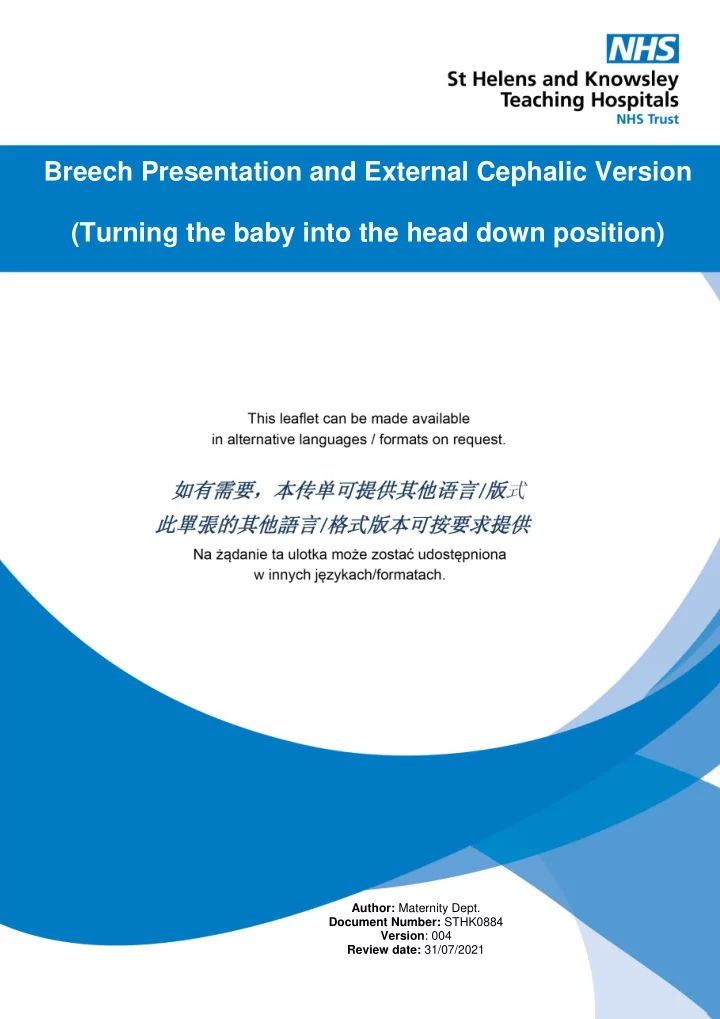

Breech Presentation and External Cephalic Version (Turning the baby into the head down position) Author: Maternity Dept. Document Number: STHK0884 Version : 004 Review date: 31/07/2021
Maternity Services Delivery Suite Contact Number 0151 430 1502 Introduction Most babies are born head first, but at the end of pregnancy around 3-4% are found to be breech. Before 37 weeks it doesn’t matter if your baby is breech, as there is a very good chance that the baby will turn spontaneously. After that time there are some babies that will turn themselves but it becomes less likely. If your baby remains in a breech position, an appointment will be made with an obstetrician to discuss your birthing options. One safe and effective way to avoid this decision of either having a caesarean section OR vaginal delivery of the baby in the breech position is to alter the position of the baby so that it becomes head first (cephalic) rather than bottom first. This is known as External Cephalic Version (ECV). It involves relaxing the muscle of your womb by means of a small injection of a drug called Terbutaline. Then moving baby so that he/she either does a forward roll or backward roll. Risks of ECV There is a small chance that by having your baby turned, labour may begin. This is why we perform E.C.V at term, so that if labour does start it would not be a problem. Immediately after ECV, there is a 1 in 200 chance of you needing an emergency caesarean section because of bleeding from the placenta and/or changes in your baby’s heartbeat.
Benefits of ECV The benefit of having a baby turned is to increase the chance of having a vaginal delivery. Success rates We are successful in approximately 60% of cases (6 in 10), although a small number may actually turn themselves back to breech. This happens in less than 5% (1 in 20) of those that are turned. Of the 19 babies turned they will remain turned. If we do not attempt to turn your baby from breech, 1 or 2 in 10 will turn themselves before labour starts, but we have no way of knowing which ones will do this. Overall, by performing ECV we should halve the number of breech presentations. What to expect ECV is performed on the Delivery Suite and you will be given a formal appointment for this. Before attempting ECV, the health of your baby is checked with a heart rate monitor and ultrasound scan. This also confirms that baby is still breech. If all is well, a small injection is given to relax the womb and so make the procedure more comfortable for you. We give this 10 to 20 minutes to work and you can sometimes feel your heart beat faster as it takes effect. With the aid of the ultrasound scan, we determine which way baby is facing, and then by pressing on your abdomen, we gently move baby and either cause he/she to roll forwards or roll backwards. This should not hurt, although it can feel uncomfortable when baby gets halfway as it stretches your womb in a different way. The ECV will be stopped if you find it too uncomfortable. Following the procedure baby’s heart rate is checked again, even if the ECV is unsuccessful. If you are Rhesus negative (blood group) we will give you an Anti-D injection. If you are Rhesus positive this is not needed. If the ECV has been successful, an appointment will be arranged for a week later in the Feto-maternal Assessment Unit to confirm that your baby is still head first. If the ECV is unsuccessful, a decision will be made as to whether a vaginal delivery or a caesarean section would be best for you. This will be fully discussed with you at the time of the ECV. Because of the time needed to perform the heart rate trace before and after the ECV, you may be on the Delivery Suite for up to 2 hours. Further information If you would like further information regarding breech presentation and external cephalic version, please ask one of the midwives or a doctor in the clinic.
Whiston Hospital Warrington Road, Prescot, Merseyside, L35 5DR Telephone: 0151 426 1600
Recommend
More recommend